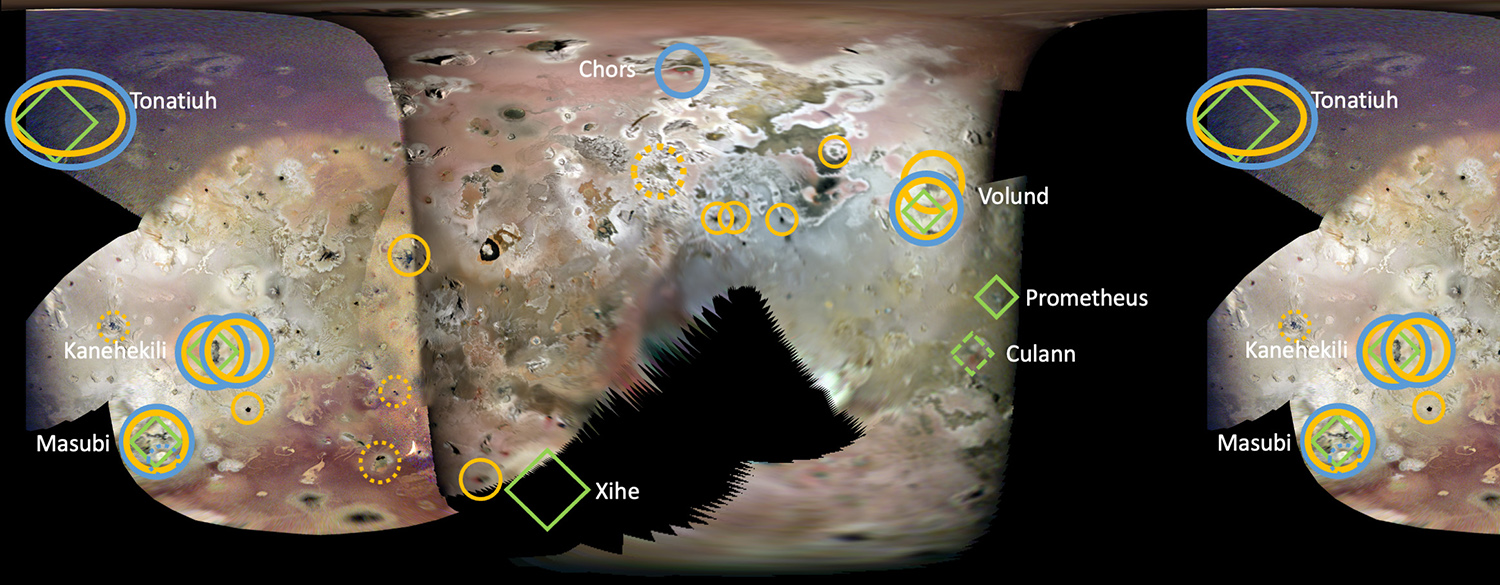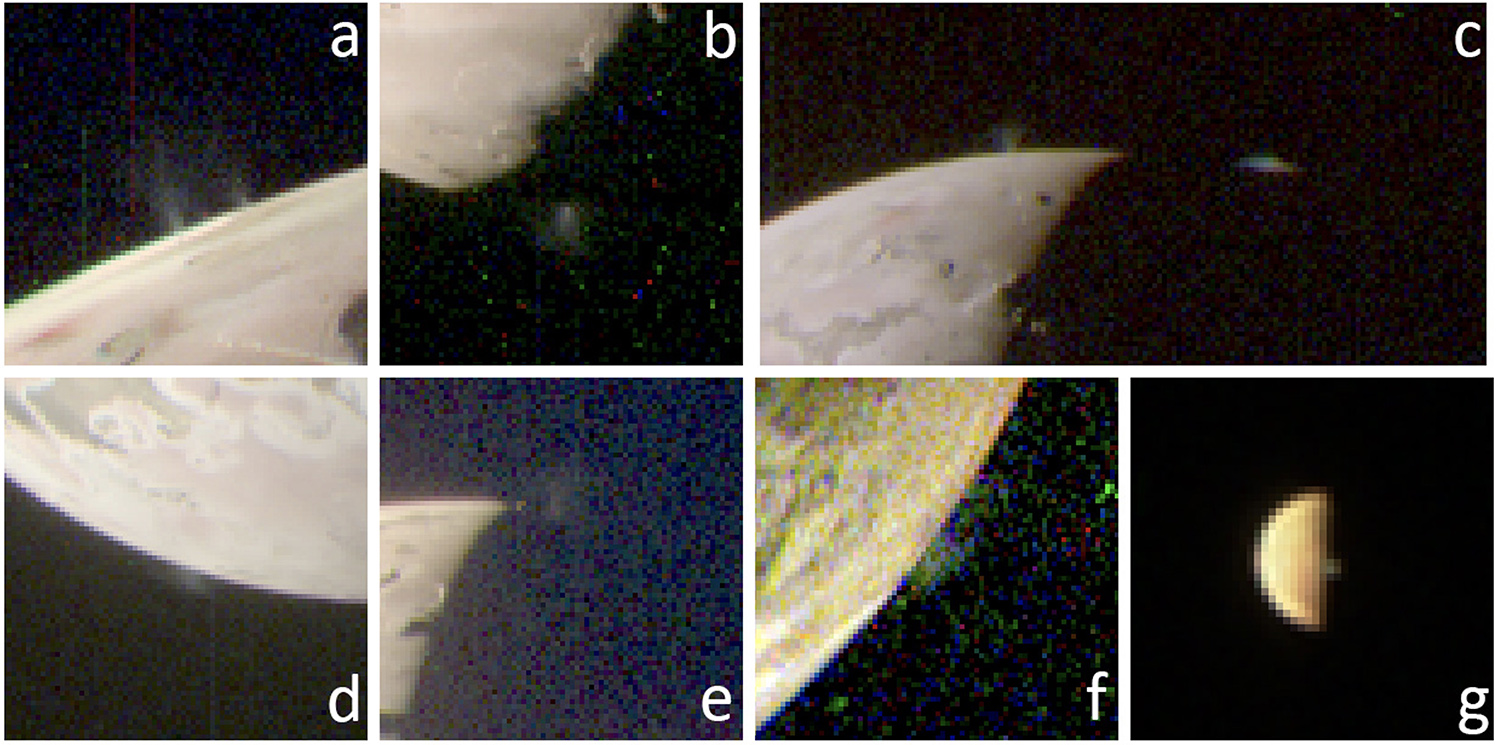- 1Malin Space Science Systems, San Diego, United States of America (ravine@msss.com)
- 2Planetary Science Institute, Tucson, United States of America (cjhansen@psi.edu)
- 3Lunar and Planetary Science Institute, Houston, United States of America (schenk@lpi.usra.edu)
- 4University of Arizona, Tucson, United States of America (jeperry1@arizona.edu)
- 5Arizona State University, Tempe, United States of America (david.williams@asu.edu)
- 6Brigham Young University, Provo, United States of America (jani.radebaugh@byu.edu)
- 7Cornell University, Ithaca, United States of America (mmp235@cornell.edu)
- 8Jet Propulsion Laboratory, Pasadena, United States of America (james.t.keane@jpl.nasa.gov)
- 9Southwest Research Institute, San Antonio, United States of America (scott.bolton@swri.org)
Introduction
NASA’s Juno spacecraft, orbiting Jupiter, had three close encounters with Io in 2023 and 2024, during which JunoCam acquired ~20 visible color images at 1 to 12 km/pixel. The area covered by these images included high latitudes not well imaged on previous missions. These images show significant changes from previous imaging. JunoCam also observed a total of nine plumes associated with volcanic features.
JunoCam instrument
JunoCam has a CCD detector with a strip filter array enabling imaging in three color bands—blue, green and red (Hansen et al. [1]). The JunoCam lens maps 58° across the 1600 pixel detector width, which is scanned by spacecraft rotation. Repeated readout of the of the CCD provides overlapping coverage in each band. A color image is generated by reprojecting each “framelet” so that each color can be mosaicked and the three colors can be composited.
Io Encounters
During the Juno extended mission (2021-present), Juno had multiple flybys of Io, the best of which occurred associated with perijove passes PJ57, PJ58 and PJ60. On PJ57 (30 December 2023), JunoCam imaged Io’s high northern latitudes from as close as 2,800 km, with a scale as small as 1.9 km/pixel (Figure 1). The dayside JunoCam images from the PJ58 Io encounter (3 February 2024) covered the mid-latitudes from as close as 3,800 km and a scale of 2.6 km/pixel (Figure 2). JunoCam also captured nightside images, illuminated by Jupiter. While the signal levels were lower in these images, the scale was as small as 1.0 km/pixel. Most recently, the PJ60 Io encounter (9 April 2024) images were from a greater distance (17,300 km) and with a larger scale (11.7 km/pixel), but they did provide coverage of the high southern latitudes.
Results
Figure 3 shows a map of Io, assembled from JunoCam coverage from PJ55, 57, 58 and 60. The map indicates the locations of surface changes either from lava flows or volatiles deposits from the JunoCam images.
Changes
Some instances of changes observed by JunoCam are as follows:
- Kanehekili Fluctus (17.2° S, 33.4° W): Kanehekili was imaged by Jupiter-shine on PJ58 at 1.8 km/pixel. It appears as an integrated, single flow field, 210 kilometers north-south and 120 kilometers east-west, similar to its appearance in the Voyager imaging, but different from the two distinct flow fields in the Galileo coverage. JunoCam also shows a large, diffuse red deposit fanning out from the western side.
- East of Kanehekili (17.7° S, 23.2° W): about 300 km east of Kanehekili, is a feature that was not seen previously, with two long, thin sets of flows, running roughly to the west and southwest from the active volcanic region at 17.2° S, 21.9° W. A diffuse red deposit, 60 by 90 km, is just to the east of this source. The terminal ends of the flows are surrounded by dark gray diffuse deposits, ~100 km across.
- Masubi Fluctus (43° S, 52.5° W): JunoCam imaged Masubi by Jupiter-shine on PJ58 and PJ60. Two new flows formed at Masubi since the New Horizons observations of 2007, running south and east from common source. The eastern flow is 120 kilometers long, while the southern flow is 170 kilometer long. The eastern flow has two distal flow lobes, each with associated dark and bright diffuse deposits.
- Nusku Patera (65° S, 3.6° W): in the sixty-six days between Juno’s PJ58 and PJ60 encounters of Io, a circular red ring, 1100 km in diameter, formed around Nusku Patera, likely from a large, Pele-type plume rich in S2.
High phase albedo reversal
The PJ58 encounter acquired images with phase angles ranging from ~130° for the first to ~90° for the fourth. This sequence shows the floors of three paterae quite bright at high phase. The floor of Loki (Figure 4), progresses from whiteish gray at high phase to darker gray at lower phase (though still brighter than the near-black seen low phase). This phase dependence would be expected from a surface with significant areal fraction of glassy component at the sub-pixel scale, like fresh lava flows.
Plumes
Nine volcanic plumes were identified in JunoCam images (Figure 5). Four came from active volcanic regions without previous plume detections (Seth, Mixcoatl, Tonatiuh, and Culann). Estimated heights of these plumes ranged from 50 to 100 km. These heights and brightness in the red-filter framelets suggest they are SO2 and dust-rich “Prometheus” type plumes. The plumes at Kanehekili, Masubi, Tonatiuh, Volund, and Xihe are associated with regions of flow-like surface changes, consistent with them being caused by mobilization of surface volatiles. Multiple plume columns were observed at Xihe and Kanehekili during the PJ58 encounter, suggesting multiple active flow lobes at these locations.
Acknowledgements
This work was funded by the National Aeronautics and Space Administration through the Juno Project. Junocam images are available at https://www.missionjuno.swri.edu and are archived with NASA’s Planetary Data System (PDS).
References
[1] Hansen, C. J., et al. Junocam: Juno’s outreach camera. Space Sci. Rev. 2014. doi10.007/s/11214-014-0079-x
Figures
Figure 1. JunoCam PJ57 Io encounter image sequence (the first image shows Io illuminated by Jupiter-shine).

Figure 2. JunoCam PJ58 Io encounter image sequence (the first two images show Io illuminated by Jupiter-shine).

Figure 3. Io mapped with JunoCam (PJ55, 57, 58 and 60), indicating changes or activity. Cyan ovals denote areas of new, faded, or shifted plume and/or volatile deposits. Yellow ovals denote areas of probable new lava flows.

Figure 4. Four views of Loki Patera from PJ58, time progressing left to right. Because of encounter trajectory, the phase angle progresses from ~130° in the leftmost image to ~90° in the rightmost image. Note the darkening of the floor of Loki as the phase angle decreases, while the rest of the region shown appears the same.

Figure 5. Plumes observed by JunoCam: a) Xihe double plume observed during orbit 58 (02/2024); b) Prometheus plume observed during orbit 55 (10/2023); c) Prometheus (left) and Seth (right) plumes observed during orbit 60 (04/2024); d) Volund plume observed during orbit 55; e) Mixcoatl plume observed during orbit 60; f) Kanehekili double plume observed during orbit 58; g) Tonatiuh plume observed at the terminator during orbit 17 (12/2018).

How to cite: Ravine, M., Hansen, C., Caplinger, M., Schenk, P., Lipkaman Vittling, L., Krysak, D., Perry, J., Williams, D., Radebaugh, J., Pettine, M., Keane, J., Hayes, A., Rathbun, J., and Bolton, S.: Results from recent close-up imaging of Io by JunoCam (perijoves 57, 58 and 60), Europlanet Science Congress 2024, Berlin, Germany, 8–13 Sep 2024, EPSC2024-731, https://doi.org/10.5194/epsc2024-731, 2024.